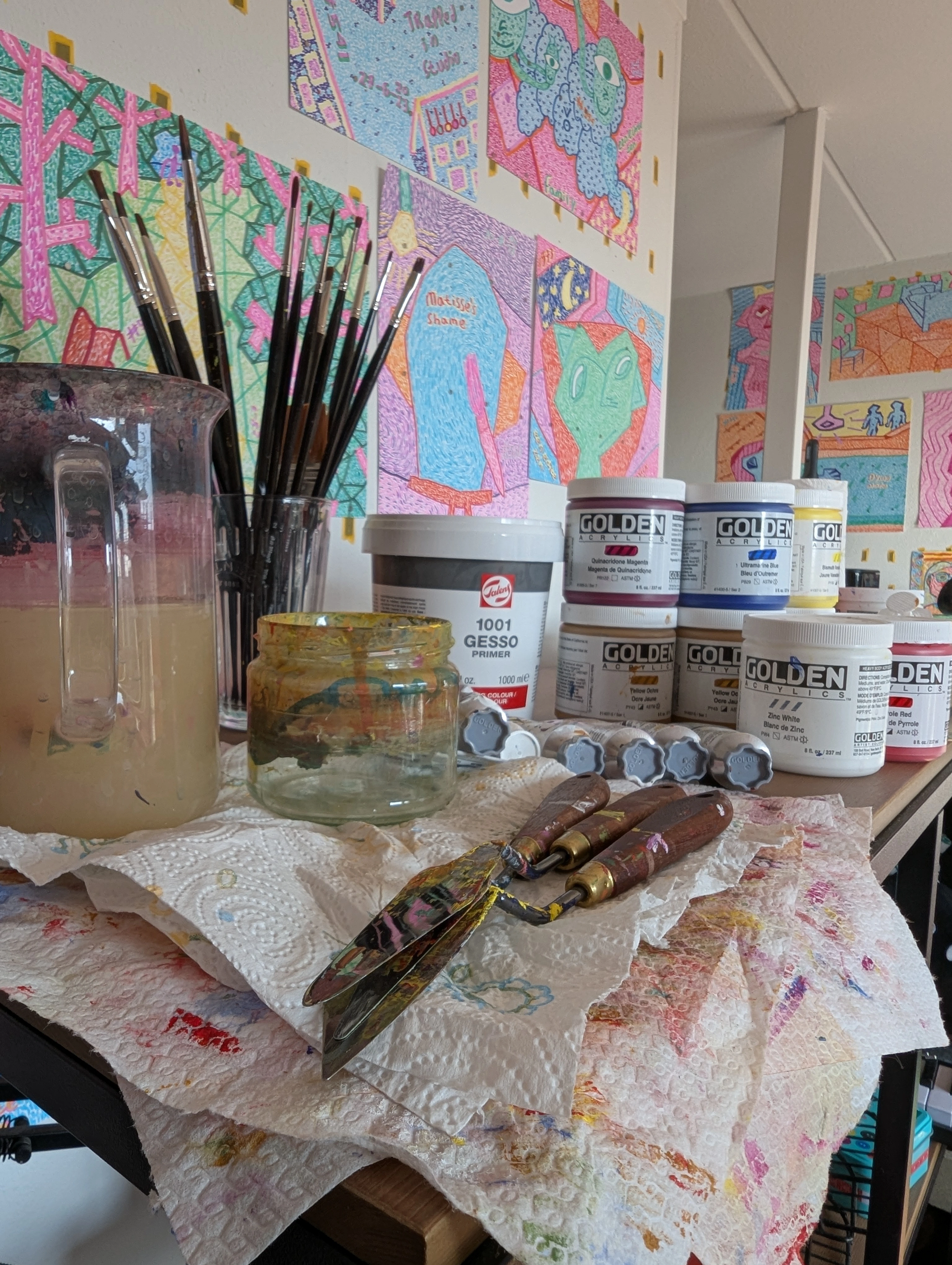
Maximalist Art Decor: An Artist's Guide to Intentional Abundance
Dive into the vibrant world of maximalist art decor with an artist's personal guide. Explore how to layer colors, patterns, textures, art, and personal collections to create a space that tells your unique story, embracing intentional abundance over clutter. Learn practical tips for embracing this joyful style, from historical roots and psychological appeal to strategic layering, lighting, and even decorating room by room. Discover how to curate your treasures, mix styles fearlessly, and make your space sing with personality.
The Joyful Chaos of Maximalist Art Decor: My Personal Dive into Intentional Abundance
Let's be honest. For a while there, it felt like the world was collectively holding its breath, trying to be as minimal as possible. Clean lines, neutral palettes, bare walls... and while there's a certain calm to that, sometimes, just sometimes, it feels a bit... empty? Like the visual equivalent of whispering when you really want to shout. I remember visiting a friend's apartment once – all stark white walls, one carefully placed grey sofa, and a single, minimalist print. It was beautiful, yes, but walking in felt less like entering a home and more like stepping into a perfectly curated, slightly sterile museum exhibit. It lacked the hum, the warmth, the life I crave in a space.
And then there's maximalism. Ah, maximalism. It's the design equivalent of a warm, enthusiastic hug from someone wearing a fabulous, slightly clashing outfit. It's bold, it's personal, and it's utterly, wonderfully more. Walking into a truly maximalist space isn't just seeing; it's feeling – the invitation to touch a velvet cushion, the hum of stories held within objects, the vibrant energy of layered colors. As an artist who loves color and texture, it speaks to my soul in a way that stark white walls just can't.
It's crucial to understand upfront: maximalism isn't about being messy or hoarding, though I'll admit my studio sometimes leans that way (a topic for another day, perhaps!). It's about intentional abundance, about surrounding yourself with things you love, things that tell your story, and arranging them in a way that feels vibrant and alive. Think of it less like a chaotic attic and more like a carefully arranged cabinet of curiosities, where every item has earned its place. Imagine walking into a room where every object sparks joy, every color sings, and every surface invites you to explore. That's the heart of curated maximalism. But how do you ensure it's abundance, not just... stuff?
Maximalism vs. Clutter: Finding the Balance
This is the big one, isn't it? The line between maximalism and just... having too much stuff. To really see the difference between abundance and just... well, stuff, let's break it down side-by-side. The difference, I think, lies in intention and curation. Clutter feels accidental, overwhelming, and often stressful. It's piles of things you don't need or love, making the space feel chaotic and difficult to navigate. There's no visual flow, just obstacles. Being in a cluttered space can feel draining, like the objects are weighing you down.
Maximalism, on the other hand, is deliberate. Every item, every layer, every color choice is there because it's loved, it's beautiful, or it contributes to the overall narrative of the space. It's about abundance, but it's curated abundance. The space feels full, but it also feels inviting and harmonious, even with all the visual information. There's a sense of flow, even if it's a winding path through visual delights. Being in a maximalist space should feel energizing, inspiring, and deeply personal.
It tells a story. Your story. And that's the real magic. As you can see in the table below, the core difference is the 'why' behind the 'more'.
Feature | Maximalism | Clutter |
|---|---|---|
| Intention | Deliberate, thoughtful arrangement | Accidental accumulation |
| Purpose | To tell a story, express personality, create sensory richness | Lack of organization, holding onto excess |
| Visual Feel | Vibrant, layered, inviting, harmonious (in its own way) | Overwhelming, chaotic, stressful, stagnant |
| Objects | Loved, meaningful, curated collections | Random, unneeded, unloved items |
| Flow | Sense of visual journey, curated vignettes | Obstacles, difficult to navigate |
| Story | Tells your unique story | Tells a story of disorganization or neglect |
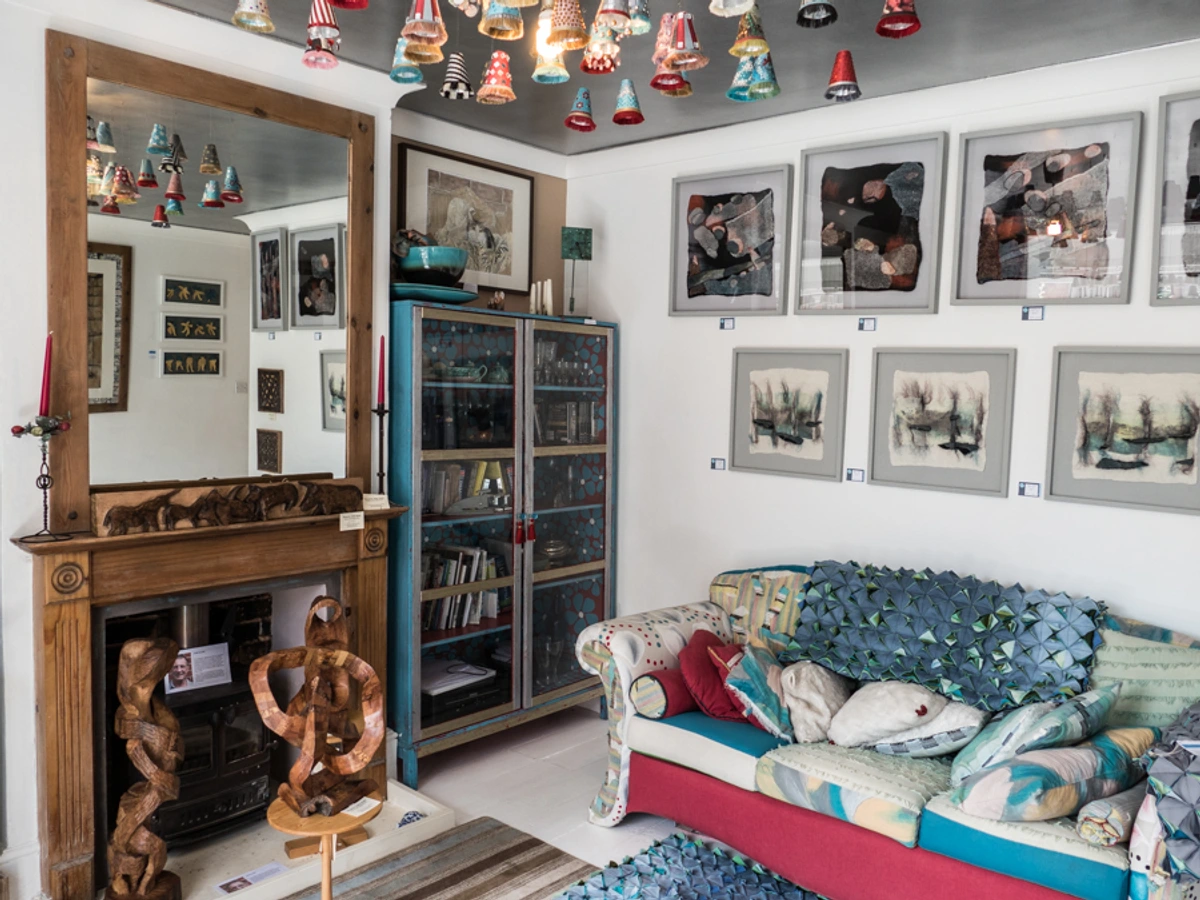
What Exactly Is Maximalist Decor? (Beyond "More is More")
Think of maximalism as the rich, complex opposite of minimalism. While minimalism strips away the unnecessary to find peace in simplicity (Art for Minimalist Interiors: Adding Soul Without Clutter), maximalism layers on the beloved, the meaningful, and the visually stimulating to create a sense of warmth, history, and personality. It's a style that embraces the full spectrum of sensory experience, inviting you not just to look, but to feel the textures, appreciate the depth, and get lost in the details.
It's not just throwing things together randomly. A truly great maximalist space is curated. It's a collection of collections, a symphony of textures, a riot of color that somehow, magically, works. It's about depth, comfort, and a fearless expression of self.
Historical Echoes: Where Abundance Found Its Voice
Maximalism today draws on a long history of embracing richness and detail in design and art. You can see echoes of this love for abundance in periods like the opulent Victorian era (think elaborate patterns, rich fabrics, and crowded display cabinets – a true love of stuff and showing it off). Victorian homes often featured heavily patterned wallpapers, layered rugs, and furniture upholstered in velvet or damask, creating a sense of cozy, enclosed richness that resonates with maximalist comfort. The motivation here wasn't just display, but creating a warm, visually dense retreat from the rapidly industrializing world outside.
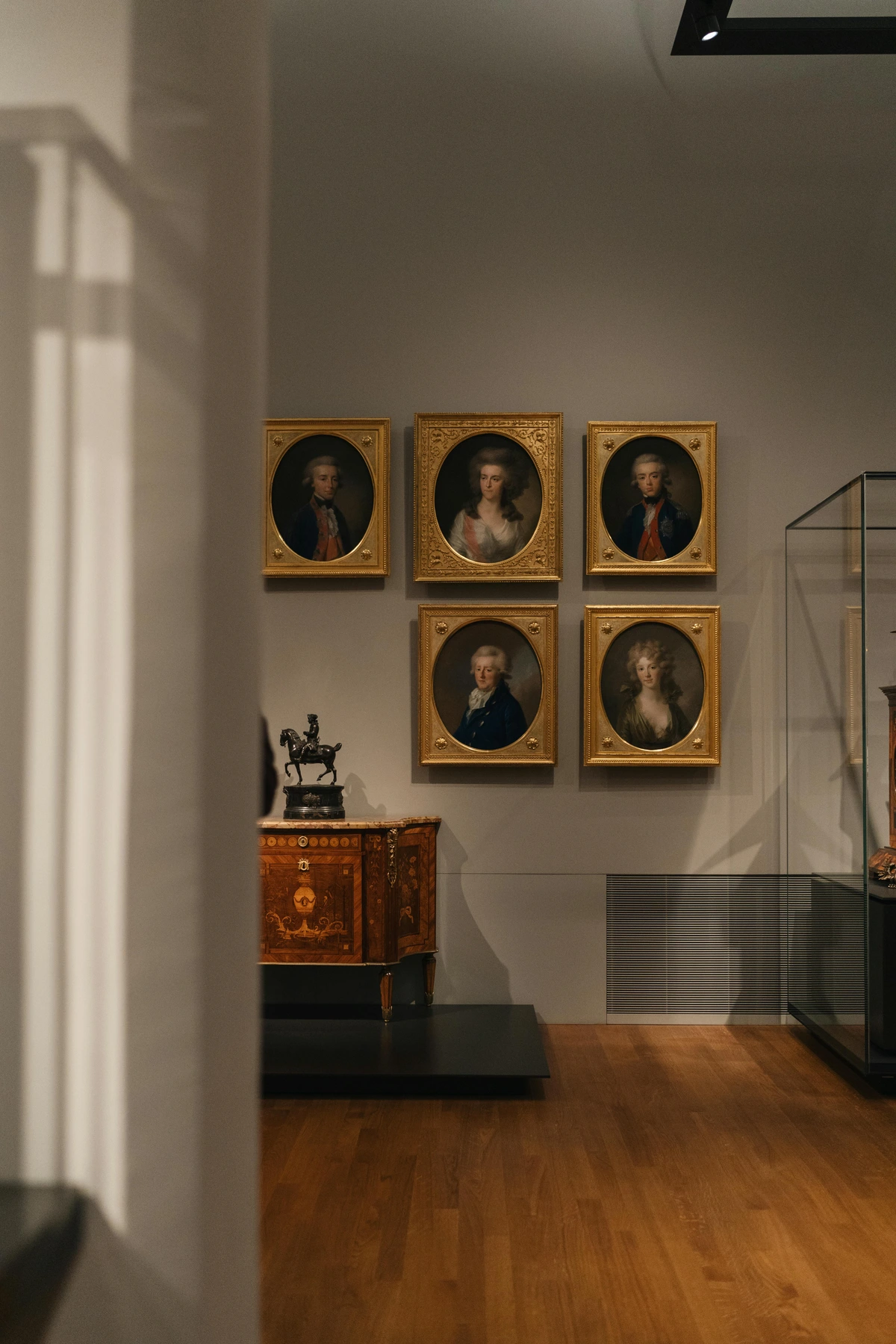
The flowing, decorative lines of Art Nouveau (Art Nouveau in Europe: A Personal Journey Through Flowing Forms & Total Art) with its organic motifs and intricate details, rejected stark industrialism in favor of decorative richness. Think of the elaborate ironwork, stained glass, and furniture with sinuous, plant-like forms – a celebration of decorative detail for its own sake, aiming to bring the beauty and complexity of nature into the built environment.
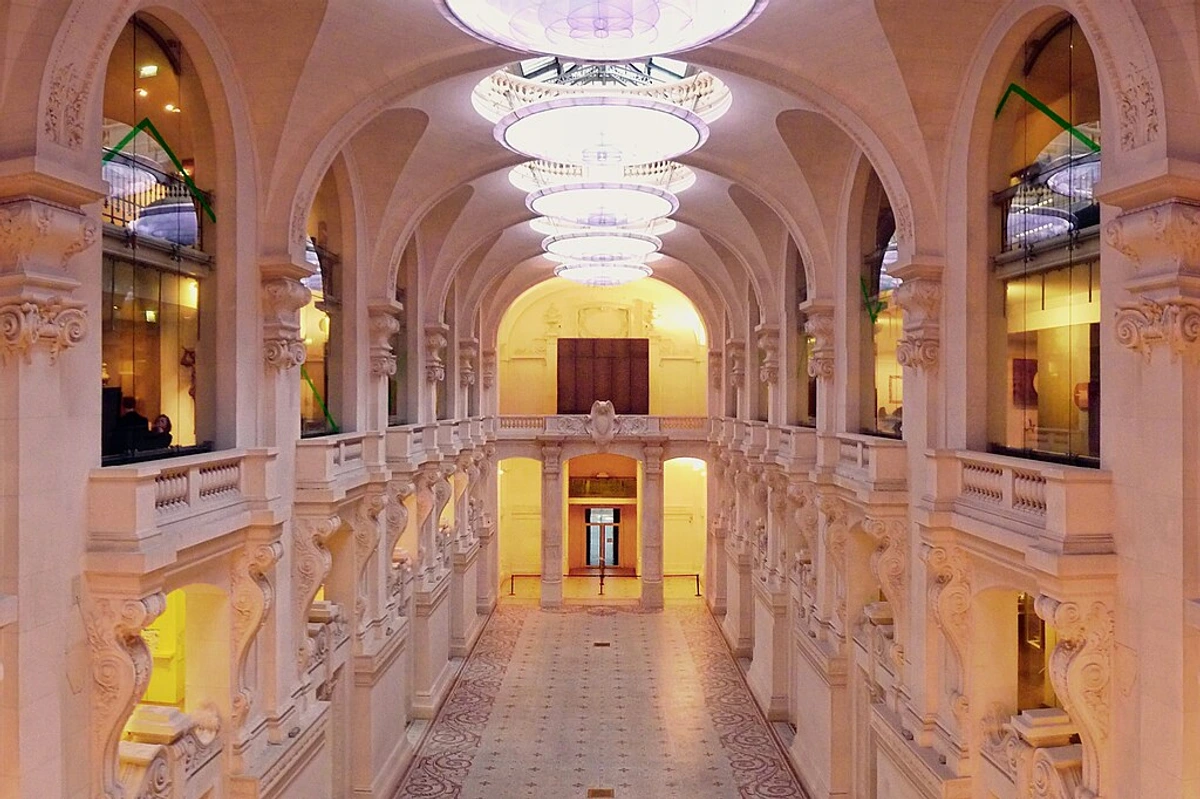
The dramatic flair of the Baroque period (Baroque Church Interior with Gold Decor)
credit, licence) with its grand scale, ornate decoration, and intense emotion, aimed to fill spaces with awe and visual complexity. The use of dramatic lighting, rich materials like gold and marble, and elaborate frescoes or carvings to cover every surface are all precursors to the maximalist desire for visual saturation and evoking strong feelings.
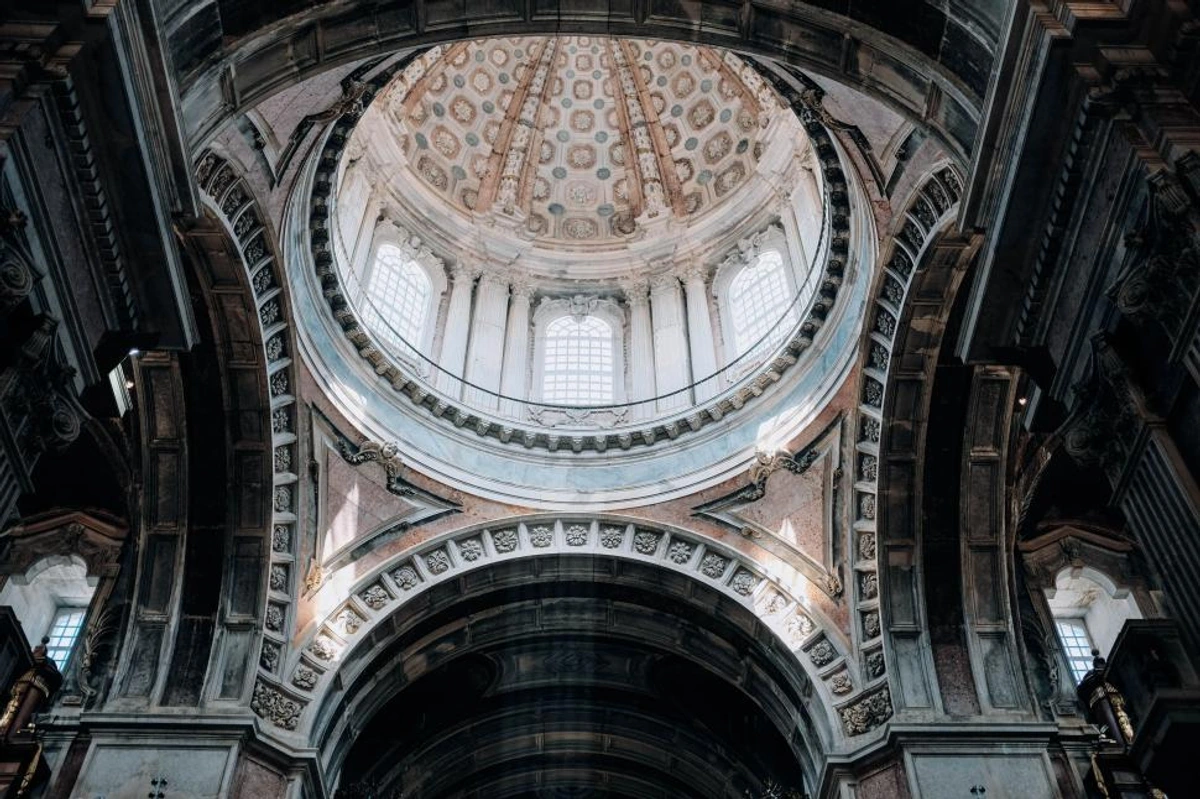
Even movements like Fauvism (Ultimate Guide to Fauvism: The Art Movement of Wild Color & Intense Emotion) and Expressionism (Expressionism: The Ultimate Guide to Art That Feels Deeply) in art, while not decor styles themselves, share that maximalist spirit of fearless color and intense emotional expression. They rejected conventional representation to prioritize subjective experience and bold palettes, much like maximalism rejects minimalist restraint for personal, vibrant expression. Maximalism today takes this historical love for 'more' and infuses it with personal narrative and modern sensibilities.
The Psychology of Maximalism: Why 'More' Feels Like Home
Beyond the visual feast, there's a deeper reason why maximalism resonates with so many, myself included. In a world that often feels chaotic and uncertain, surrounding yourself with objects that hold meaning, memories, and beauty can create a powerful sense of comfort and security. It's like building a personal fortress of joy. Each object tells a story, a reminder of a place, a person, or a moment in time. This layered history creates a feeling of rootedness and continuity. For me, the comfort comes from being enveloped by things that represent my journey, my interests, and the people I love. It's a constant, tangible reminder of a rich inner and outer life.
It's also incredibly stimulating for the senses – the feel of different textures, the vibrancy of colors, the visual stories unfolding in every corner. It's an environment that encourages exploration and engagement, a stark contrast to spaces that might feel cold or impersonal. Think of it like creating your own personal 'hygge' or 'nesting' space, but instead of quiet simplicity, it's built from layers of vibrant life and cherished objects. While minimalism can feel restrictive or even sterile to some, maximalism offers a sense of liberation and authentic self-expression. It's about creating a space that is as rich and complex as your own inner world, a physical manifestation of your personality and journey.
Key Elements of Maximalist Art Decor: Building Your Abundant Story
Okay, so we've talked about the why, the deep-seated need for a space that feels alive and personal. Now, let's dive into the how. What are the tangible ingredients that make a maximalist space sing? Remember, it's less about following strict rules and more about embracing a mindset of joyful accumulation and thoughtful arrangement. So, if maximalism speaks to your soul for these reasons, let's look at the tangible ways to bring that feeling to life...
Architectural Details: The Foundation of Richness
Don't overlook the bones of your space! Architectural details can be powerful contributors to the maximalist aesthetic. Think about painting trim in a bold, contrasting color, adding patterned crown molding, installing decorative wall panels like wainscoting or picture rails, or even using ornate ceiling medallions. These elements add another layer of visual interest and historical depth, creating a rich backdrop for your curated collections. It's like giving your space a beautiful, ornate frame before you even start filling it. Even if you can't add permanent features, consider temporary solutions like peel-and-stick wallpaper with a bold pattern or decorative appliques for furniture. These details set a tone of deliberate richness from the ground up.

Color, Color, Everywhere (But Thoughtfully)
Forget the fear of color! Maximalism revels in bold palettes, contrasting hues, and rich tones. You can mix vibrant primaries with deep jewel tones, or combine unexpected shades. The key is to do it with confidence. Think about how artists use color – it's about creating mood and energy. A color wheel can still be your friend, even when you're breaking all the rules – it helps you understand how colors interact, whether you're aiming for high-contrast drama with complementary colors or rich, enveloping harmony with analogous ones. Imagine a room where emerald green walls meet a sapphire blue sofa, accented by ruby red pillows and a golden yellow rug. It's a feast for the eyes! Don't forget the walls and even the ceiling themselves can be part of the color story – think patterned wallpaper or a painted ceiling as a foundational layer. Common strategies include using a dominant bold color on walls or a large piece of furniture, then layering with contrasting or complementary colors in textiles, art, and objects. Jewel tones like emerald, sapphire, ruby, and amethyst are popular for their richness. For me, one of my favorite risky color choices was painting a small, often-overlooked hallway a deep, moody teal and then filling it with bright, clashing abstract art. It felt wrong on paper, but in person, it's incredibly vibrant and welcoming, a little jewel box of color.
![]()
Layering Like a Pro (Art, Textiles, Objects, Furniture)
This is where the "more" comes in, and it's fundamental to creating that sense of curated abundance. Think gallery walls packed floor-to-ceiling, mixing different frame styles and sizes. The trick to mixing frames is often finding a unifying element, like color palette or material, or simply embracing the deliberate contrast for visual excitement. Layer rugs on top of carpets or other rugs. Pile on the pillows and throws. Combine different furniture styles and eras – a sleek modern sofa next to a vintage armchair, or a rustic wooden table with ornate chairs. It's about creating visual depth and interest, but also a sense of comfort and being enveloped by your surroundings. Imagine a wall covered floor-to-ceiling in framed prints next to a velvet armchair piled high with embroidered pillows and a patterned throw. That's the kind of visual richness we're talking about. Beyond art and textiles, layer decorative objects on every surface – stacks of books, sculptures, vases, framed photos, or collected treasures on coffee tables, side tables, and shelves. Don't just place things; arrange them in curated vignettes that tell mini-stories. This layering creates a visual journey, inviting the eye to linger and discover.
If you're wondering How to Decorate Your Home or specifically How to Decorate a Wall, maximalism gives you permission to go big and bold with your art display.
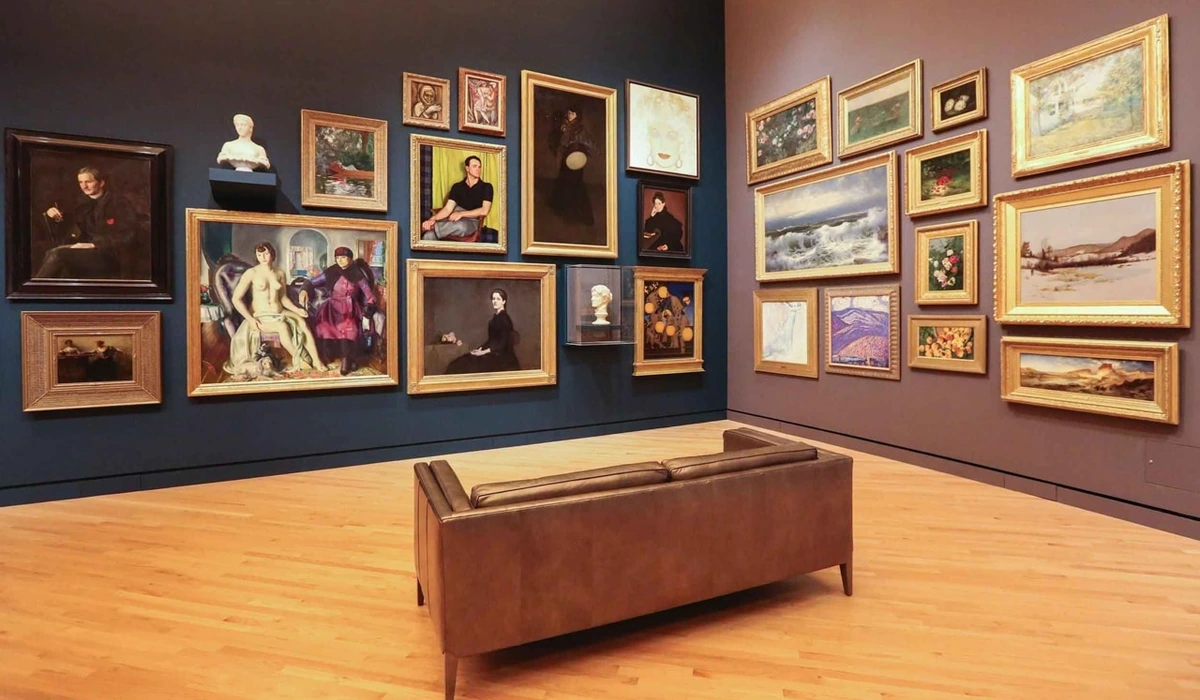
Texture and Pattern Play: A Sensory Symphony
Mix them all! Velvet with linen, rough wood with polished metal, intricate florals with bold geometrics. The contrast in textures and patterns adds visual excitement and prevents the space from feeling flat. Don't be afraid to combine patterns that you might initially think clash – in maximalism, they often create a surprisingly harmonious effect. A common technique is to vary the scale of patterns: mix a large floral wallpaper with a small striped rug and a medium geometric cushion. This variation prevents patterns from blending into a visual mush and instead creates distinct layers of interest. Think of combining a bold floral wallpaper with a striped rug and a collection of ceramic birds displayed on a rustic wooden shelf. It's unexpected, but it works! Incorporating different materials like wood, metal, glass, ceramic, and even natural elements like stone or shells adds another dimension to the texture play, making the space feel rich and tactile.
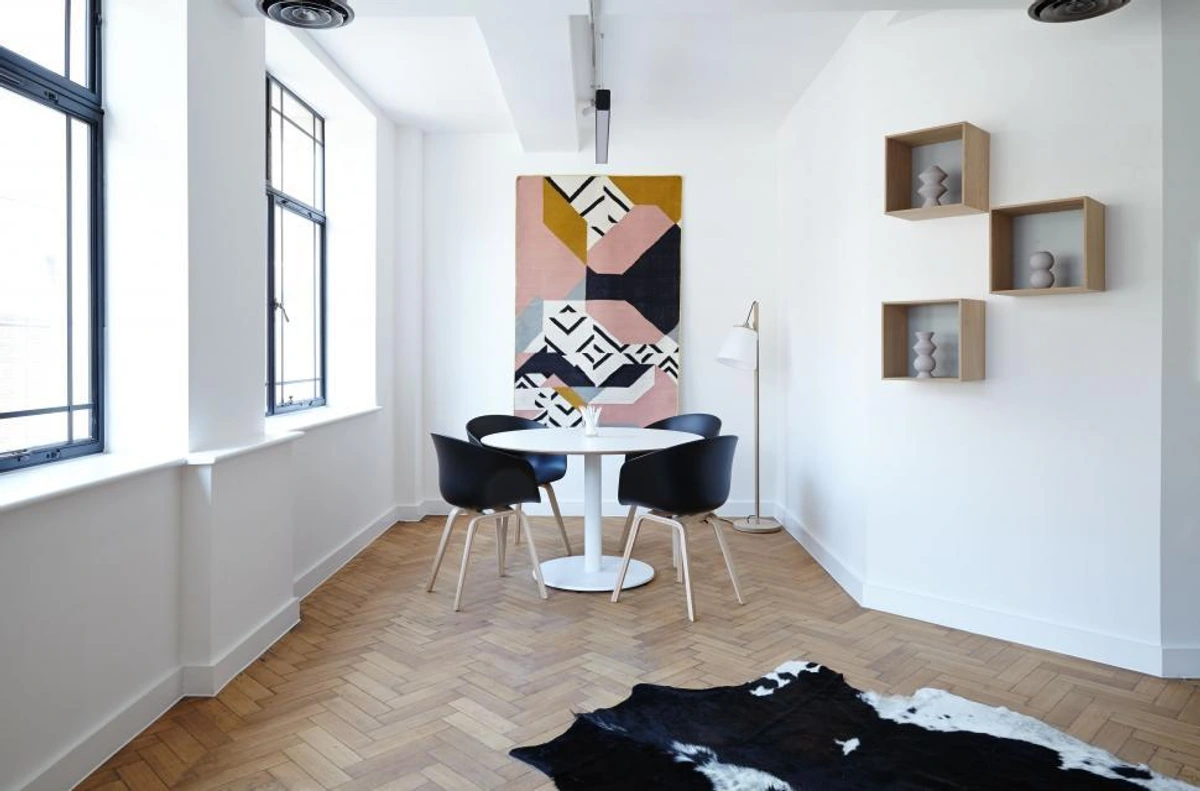
The Power of Personal Collections: Your Story on Display
Maximalism is the perfect style for collectors. Display your passions! Whether it's collecting drawings & sketches, vintage ephemera, objects from your travels, or items related to your hobbies like vintage cameras, musical instruments, or unique ceramics, arrange them proudly. These personal touches are what give a maximalist space its soul and narrative. Instead of tucking away your treasures, group them together to create curated vignettes on shelves, in display cases, or on tabletops. My own collection of vintage ceramic birds, for instance, becomes a focal point when grouped together on a prominent shelf, telling a small story about my interests. Don't forget the power of displaying books – stacks on tables, overflowing shelves, they add color, texture, and a sense of lived-in history. Consider creative display methods like using shadow boxes for smaller items, integrating collections directly into bookshelves, or creating themed displays that tell a specific story. These collections are the heart of your space's narrative.
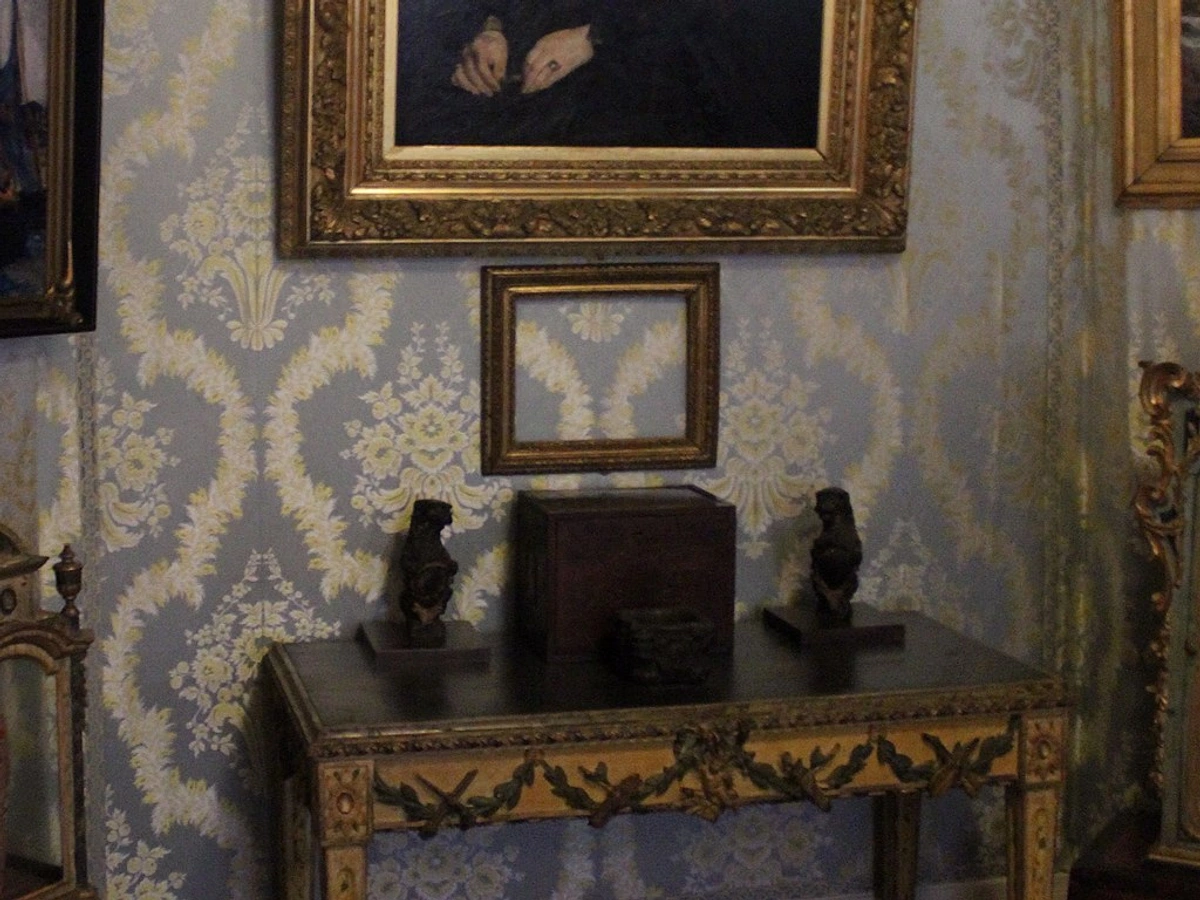
Bold Art Choices: Making a Statement
Art is central to maximalism. Go for pieces that you love, that are vibrant, and that make a statement. Don't be afraid of large-scale works or mixing different types of artwork like paintings, sculptures, and prints. Maximalism is a fantastic backdrop for showcasing a diverse art collection. The framing of your art can also contribute to the maximalist aesthetic – think ornate gold frames mixed with simple black ones, or even layering framed pieces. Art can be integrated into the layers – place smaller pieces on shelves among objects, lean larger pieces against walls layered with furniture or wallpaper. If you're looking to buy art for your maximalist space, consider vibrant abstract art, bold Pop Art, or expressive pieces from movements like Fauvism or Expressionism. Don't be shy about exploring different art styles! Most importantly, choose art that evokes emotion and resonates with your personal story. My own colorful, layered prints and paintings, available here, often find a natural home in maximalist settings, adding another layer of personal expression.
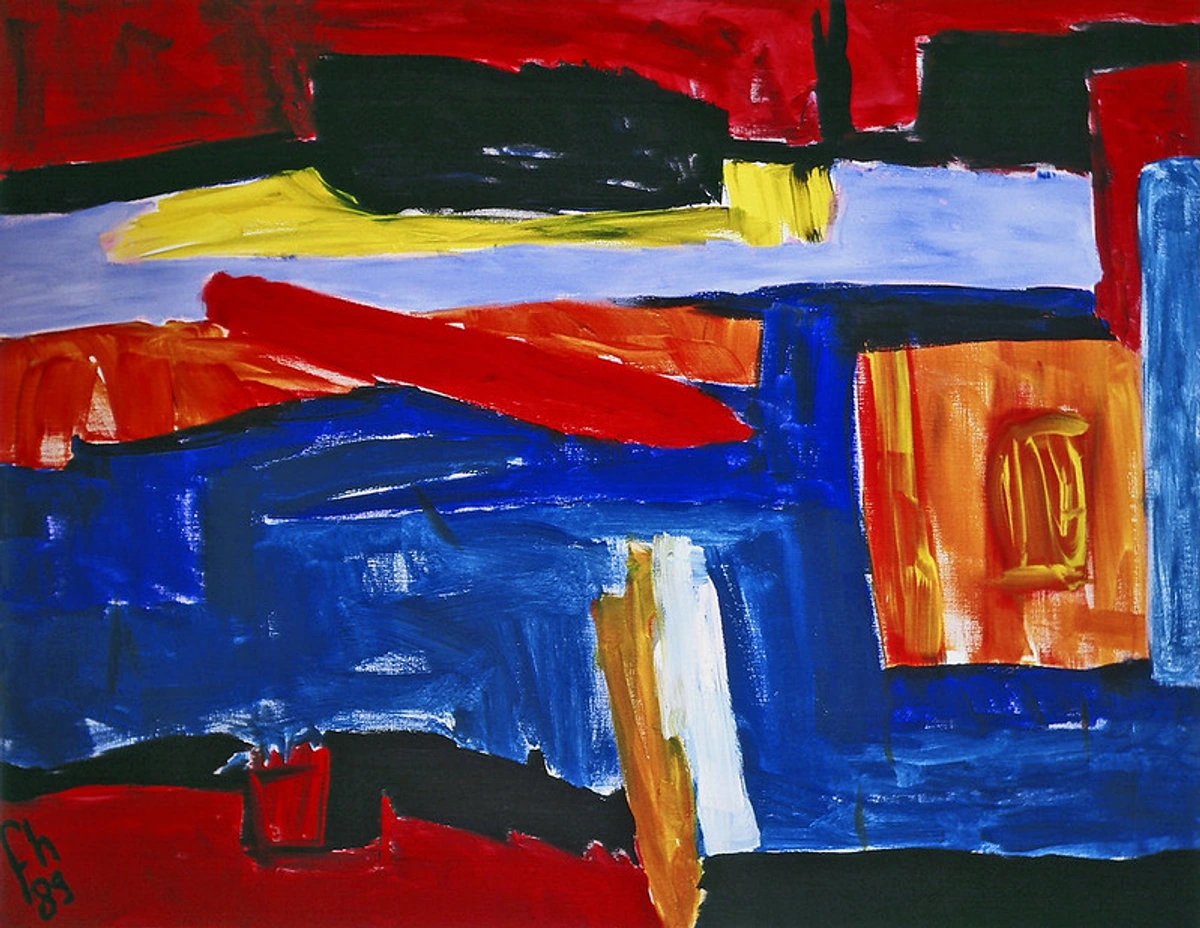
Strategic Lighting: Highlighting Your Treasures
In a space filled with abundance, lighting is crucial. It's not just about seeing; it's about highlighting your treasures and creating mood. Use a mix of ambient, task, and accent lighting. Spotlights or picture lights can draw attention to specific artworks or collections, while lamps with patterned or textured shades add another layer of visual interest. Consider incorporating fairy lights or candles for a touch of whimsical warmth and layered light. Strategic lighting prevents the space from feeling dark or overwhelming, ensuring that even with 'more', everything feels intentional and inviting. It's the final touch that makes your treasures truly shine, guiding the eye through the visual richness.
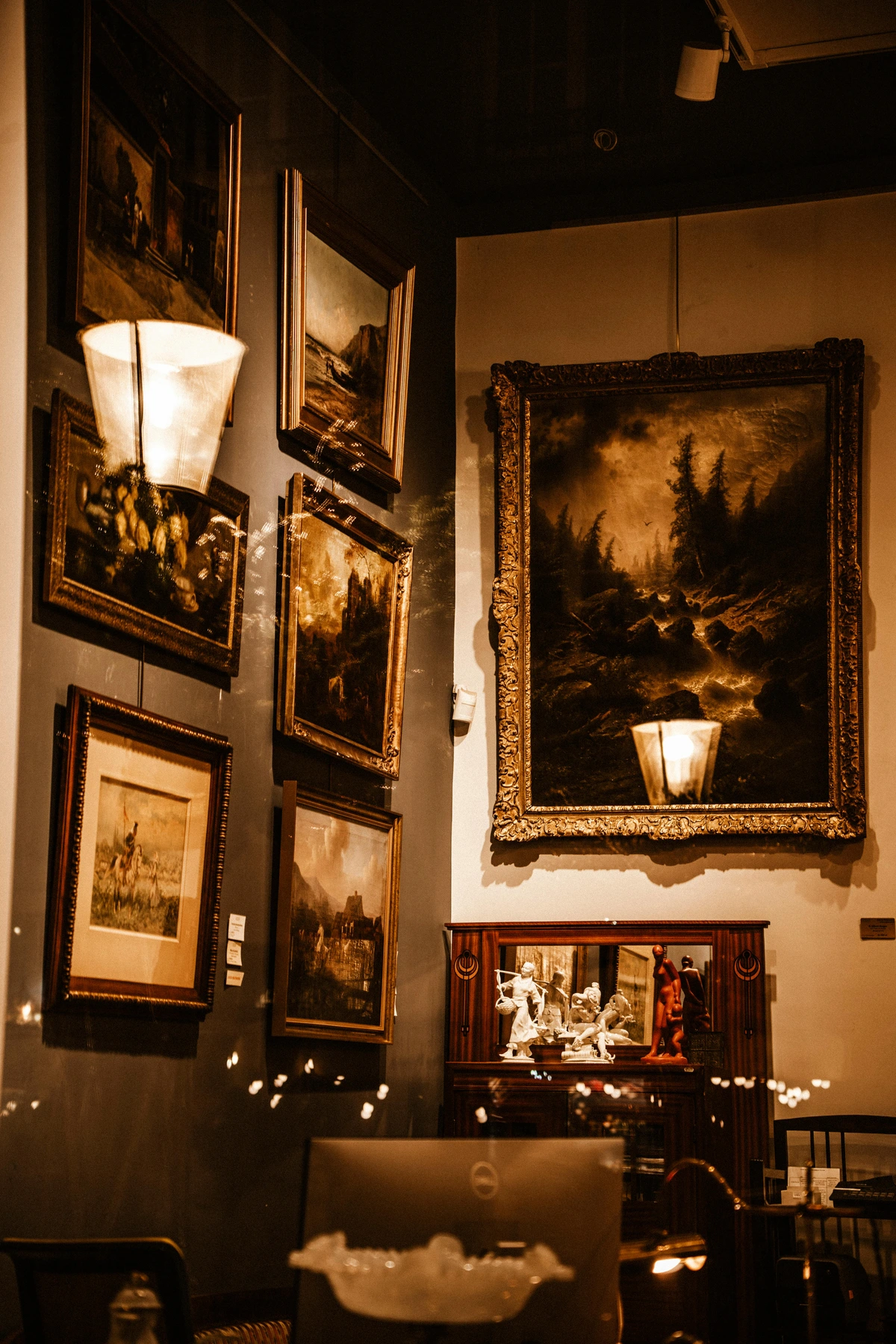
Mirrors: Reflecting and Expanding the Abundance
Mirrors are a maximalist's secret weapon. They don't just reflect light; they reflect and multiply the visual richness of the space. An ornate, oversized mirror can be a focal point, adding a layer of historical grandeur. Grouping mirrors of different shapes and sizes on a wall creates another kind of layered display. Placing a mirror opposite a gallery wall or a vibrant collection doubles the impact and makes the space feel larger and even more abundant. They add sparkle and depth, preventing a heavily layered room from feeling stagnant. Consider mirrors with interesting frames or unique shapes as art pieces in themselves, adding another reflective layer to your story.
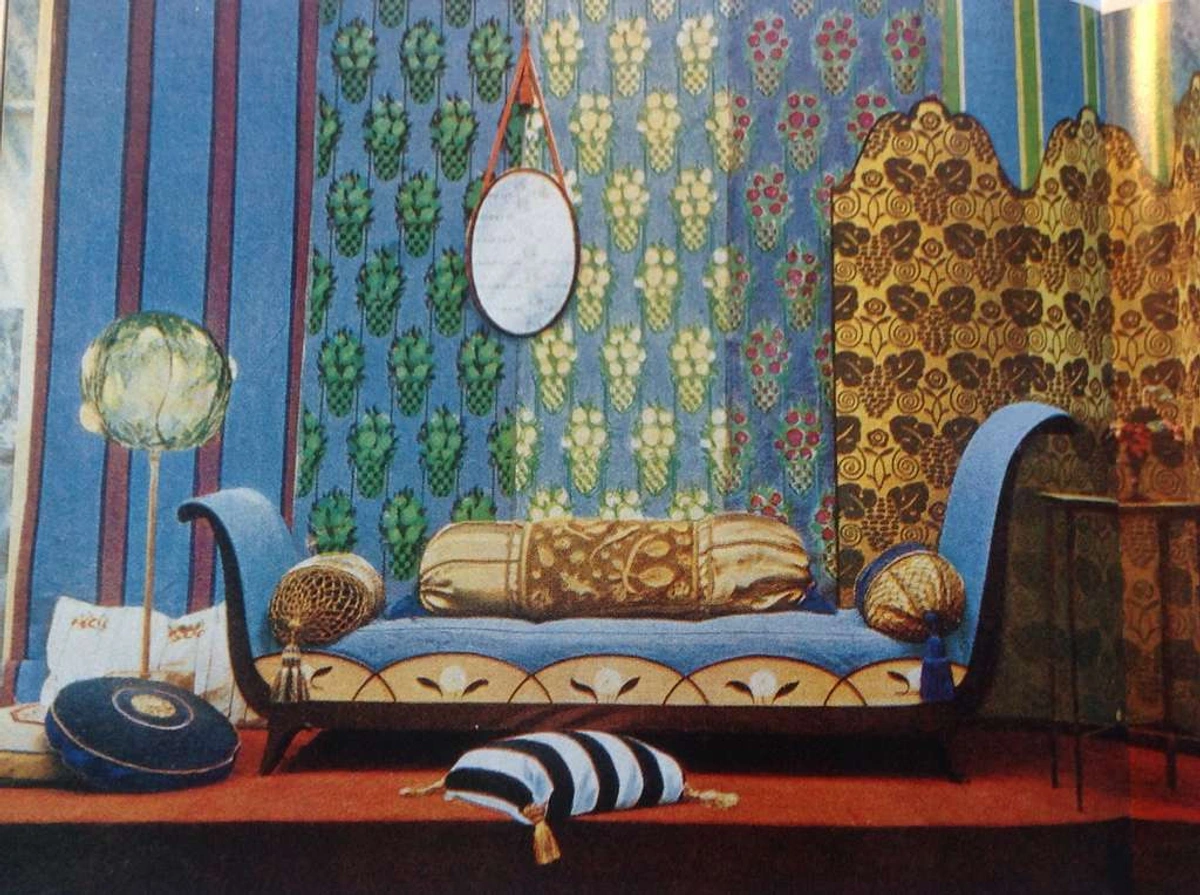
Plants and Greenery: Bringing Life In
Plants add life, texture, and another layer to the maximalist aesthetic. They bring the outdoors in and contribute to the feeling of abundance and vitality. Mix different sizes, types, and heights of plants. Hang them, place them on shelves, group them on the floor. The lushness of greenery contrasts beautifully with bold colors and patterns, adding an organic, living layer to the curated abundance. They literally breathe life into the space, making it feel vibrant and dynamic.
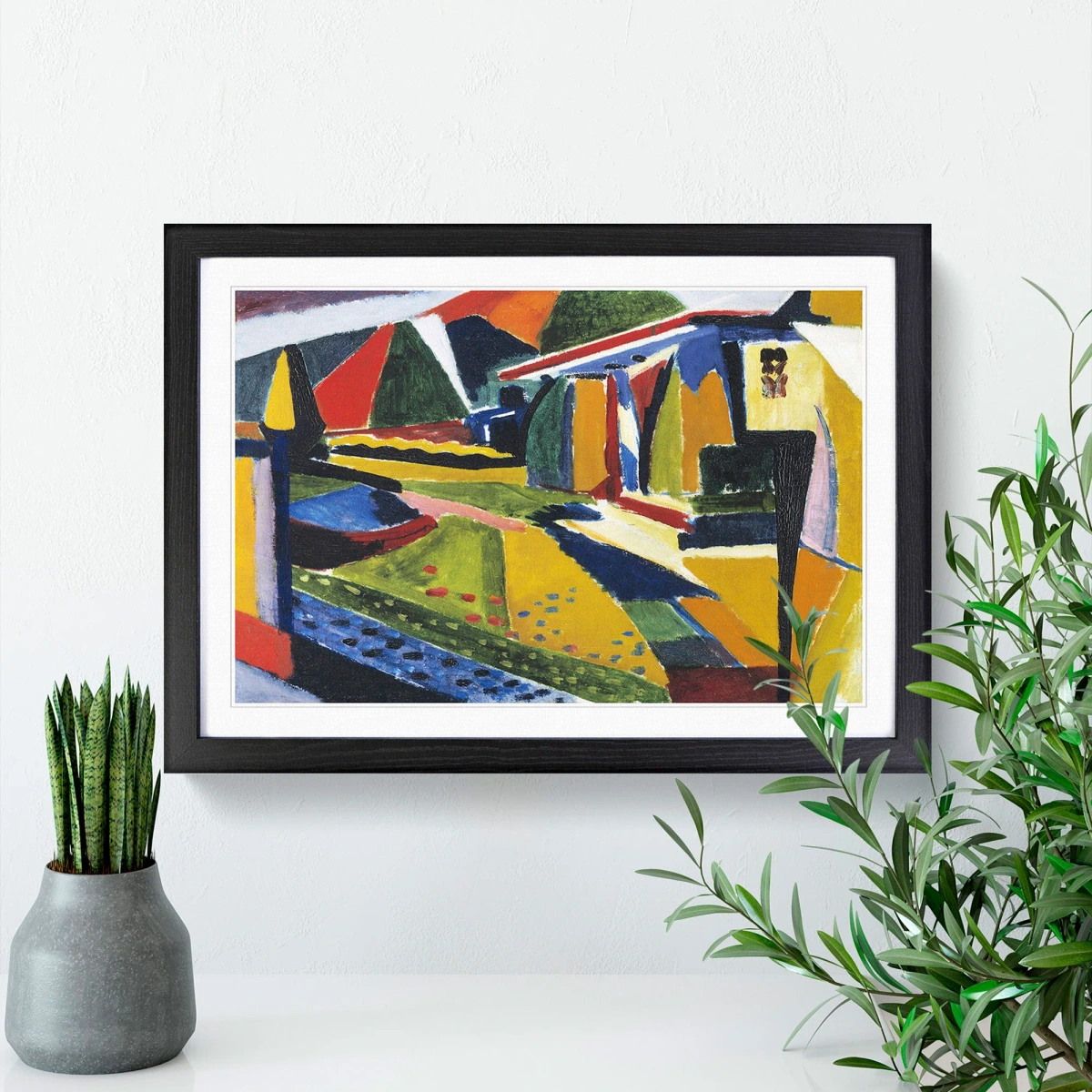
Incorporating Vintage and Antiques: Layers of History
A key part of the maximalist story is the inclusion of pieces with history. Vintage furniture, antique decorative objects, or even old books add layers of time and narrative to your space. These pieces often come with their own unique textures, patterns, and colors, fitting perfectly into the layered aesthetic. Mixing these historical elements with contemporary pieces is a hallmark of a well-curated maximalist interior. Think about the stories these objects carry! A chipped teacup from your grandmother or a vintage map from a place you've always dreamed of visiting adds a personal layer that new items simply can't replicate. They are tangible links to the past, woven into your present.

Engaging the Senses Beyond Sight: The Full Experience
While maximalism is visually rich, it's also about creating an immersive experience. Don't forget scent and sound! Introduce scented candles, diffusers, or fresh flowers for a pleasant aroma. Consider a vintage record player or a carefully chosen sound system to add an auditory layer. These elements contribute to the overall feeling of warmth, comfort, and lived-in abundance. They complete the sensory tapestry, making your space a truly enveloping haven. For me, lighting a specific scented candle and putting on some old jazz records instantly transforms my space into a cozy, inspiring haven, engaging more than just my eyes.
Smart Storage & Organization: Taming the Treasures
Yes, even in maximalism, organization matters! It's the difference between intentional abundance and overwhelming clutter. Smart storage solutions, like beautiful cabinets, decorative boxes, or well-organized bookshelves, allow you to display your collections while keeping things tidy. Think of storage itself as another layer – a vintage cabinet displaying ceramics, or decorative boxes holding smaller treasures. It's about making sure every item feels like it's part of the curated story, not just piled up randomly. Organization in maximalism is about accessibility and appreciation of the objects, not hiding them away. You want to be able to easily find and enjoy your treasures, ensuring the abundance feels joyful, not stressful.
Maximalism Room by Room: Bringing the Vibe Everywhere
So, how does this translate to different spaces in your home? Maximalism isn't just for the living room; it can infuse every corner with personality and joy, transforming functional areas into vibrant expressions of self.
- Living Room: This is often the easiest place to start. Go bold with a patterned rug (or two!), layer throws and pillows on the sofa, create a floor-to-ceiling gallery wall, and fill bookshelves with books and collected objects. Mix furniture styles fearlessly. Consider a statement armchair in a vibrant color or pattern, or a large, ornate mirror over the fireplace. The living room becomes a plush, story-filled cocoon, inviting conversation and relaxation.

- Bedroom: Create a cozy, layered sanctuary. Think rich textiles on the bed (velvet, silk, multiple patterned pillows), a mix of art above the headboard, layered rugs, and bedside tables filled with personal treasures and interesting lamps. It's about creating a cocoon of comfort and personality. Don't forget the walls – a bold wallpaper or a deep paint color can make the space feel instantly more intimate and luxurious. Your bedroom should feel like a warm, enveloping embrace.
- Kitchen & Dining: Don't shy away from color and pattern here! Bold wallpaper, open shelving displaying colorful ceramics and glassware, vibrant art on the walls, and patterned tablecloths or cushions can transform these functional spaces into joyful hubs. Displaying collections of vintage kitchenware or unique mugs adds personal flair. Consider painting cabinets a bold color or adding a patterned backsplash. The kitchen transforms into a vibrant, appetite-whetting hub, full of life and personality.

- Office/Studio: Your creative space should reflect your energy! Surround yourself with inspiring art, objects, and books. Use colorful storage solutions, display your own work or works-in-progress, and layer textures with rugs and textiles. My own studio, while sometimes leaning towards chaos, is definitely maximalist in spirit – filled with art supplies, books, and pieces that spark ideas. It's a space that feels alive with creative energy, a true reflection of the artistic process.

- Bathroom: Even small spaces can embrace maximalism. Bold wallpaper, a gallery wall of small framed prints, colorful towels, and decorative objects on shelves can make a big impact. Just be mindful of humidity for certain materials! Consider a statement mirror or unique light fixture to add a touch of luxury. A maximalist bathroom can be a surprising, delightful jewel box.
- Hallways & Entryways: These often-overlooked transitional spaces are perfect for making a strong maximalist first impression. Go bold with patterned wallpaper or a vibrant paint color. Create a mini-gallery wall, add a console table layered with objects and a statement lamp, or hang an ornate mirror. These areas can be little bursts of personality that set the tone for the rest of your home.
How to Embrace Maximalism in Your Own Space: My Tips for Joyful Abundance
Feeling inspired but a little overwhelmed by the idea of 'more'? That's completely understandable! It's a journey, not a race, and it's deeply personal. Here's how I'd approach it, perhaps drawing on my own trial-and-error (mostly error, if we're being honest about my studio!). I once tried to put everything I owned on display, and let me tell you, that crossed the line into 'hoarder chic' very quickly. The key is the intentionality. It's about curating your world, not just accumulating.
Getting Started
- Start Small: Pick one room, or even just one wall or corner. Experiment there before committing to the whole house. A gallery wall is a great starting point. Or maybe just one boldly patterned rug and a few new, colorful pillows. See how it feels to add a little 'more'. Even in a small apartment, you can embrace vertical layering with tall bookshelves or floor-to-ceiling art. It's about dipping your toes in, not diving headfirst. You could even start smaller, like styling a single bookshelf or creating a curated vignette on a side table.
- Find Your Inspiration: Where does your 'more' come from? Look to places that already embrace abundance and history. Think about visiting museums (especially those with historical interiors or decorative arts sections), exploring design books, or diving into online communities like Instagram and Pinterest for visual ideas. Travel can also be a huge source of inspiration, bringing back objects and memories to weave into your space. What visual stories resonate with you?
Mindset & Approach
- Focus on What You Love: Maximalism isn't about filling space for the sake of it. It's about surrounding yourself with things that bring you joy or have meaning. Your space should tell your story. If you don't love it, don't keep it, no matter how 'maximalist' it seems. This is the core of the 'curated' aspect. Take time to really look at your possessions and ask yourself, "Does this belong in my story? Does it make me happy?" If the answer is no, it's just clutter.
- Embrace Imperfection: Unlike some styles that strive for flawless execution, maximalism embraces the lived-in, slightly imperfect nature of a home filled with history and personality. Don't stress about everything being perfectly aligned or spotless. A little bit of charming chaos is part of the look! It's about comfort and authenticity, not a showroom. This ties back to the storytelling – imperfections are part of the story.
- Think About Balance (Yes, Really): Even in abundance, there needs to be some visual balance. Distribute color and pattern throughout the room. Use lighting to highlight key areas and prevent the space from feeling heavy or dark. Practically, this might mean ensuring some visual pathways remain clear, using a consistent background color (like wall paint) to tie disparate elements together, or strategically placing a mirror to reflect light and visual interest. Sometimes, even a small area of 'Negative Space: Abstract Art's Unseen, Powerful Secret Weapon' (a less cluttered corner, a plain wall section) can provide a visual break that makes the abundance elsewhere feel more intentional. It's about visual harmony within the richness, not just throwing things everywhere.
- Don't Be Afraid to Change: The beauty of maximalism is that it's fluid. You can easily swap out art, textiles, or objects to refresh the space or reflect your evolving tastes. It's a living, breathing space, just like you. Your story evolves, and so can your decor. Consider periodically editing your displays, putting some items away and bringing out others. This allows you to appreciate different pieces and keeps the visual story evolving.
- Compromise (If Needed): If you live with someone who prefers a more minimalist style, maximalism might require some negotiation. Designate specific zones for maximalist expression (like your office or a specific wall), or find ways to incorporate maximalist elements (like bold art or layered textiles) within a cleaner overall structure. It's about finding a balance that works for everyone's comfort and style.
Practical Application
- Layer, Layer, Layer: Start with a base (paint color, large furniture) and build up. Add textiles, then art, then smaller decorative objects. Don't be afraid to overlap or place things in unexpected spots. Remember, it's about creating depth and a feeling of being enveloped. Think rugs on rugs, pillows on pillows, art over wallpaper. It's like building a rich visual tapestry, piece by piece.
- Mix and Match Fearlessly: Combine vintage finds with modern pieces, high-end art with affordable prints. The juxtaposition is part of the charm. (Speaking of prints, if you're wondering Why Buy Art Prints?, they're a fantastic way to add color and variety affordably!). Don't be afraid to mix a flea market find with a piece from a gallery. It's the mix that makes it personal and interesting.
- Incorporate Your Own Creativity: If you're an artist or maker, display your own work! Your own paintings, sculptures, or crafted objects are the most personal elements you can add. Even if you're not an artist, maybe you have a collection of things you've made or projects you're proud of – show them off! It's your story, after all.

- Weave in Your Personal History: Go beyond just displaying objects. Think about how you can visually represent your life story. Frame old family photos, display heirlooms, create a wall of postcards from places you've traveled, or showcase your children's artwork. These elements are the threads that connect the space to you and make it truly unique.
Sourcing & Maintenance
- Sourcing Your Treasures: Where do you find all these wonderful things? Explore local flea markets, antique shops, and estate sales for unique vintage finds. Don't forget online marketplaces for both vintage and contemporary pieces. Consider supporting independent artists directly online or at local art fairs. And importantly, supporting independent artists and makers – their work adds a truly personal and often vibrant touch that fits perfectly into a maximalist home. Sourcing second-hand items also aligns beautifully with maximalism's love of history and unique objects, and it's a more sustainable approach. My own art, for instance, is available here.
- A Note on Maintenance: Yes, more stuff can mean more dusting. Embrace it as part of the process, or perhaps invest in a good duster and schedule regular 'treasure tidying' sessions. A little upkeep ensures your intentional abundance doesn't tip into unintentional chaos. It's a small price to pay for living surrounded by things you love, right? If you're worried about keeping things clean, especially textiles and objects, establishing a simple routine for dusting and tidying can make a big difference. Think of it as caring for your curated collection.
- Curate Your Collections: This deserves its own point. Maximalism isn't just putting everything out. It's about selecting the items that truly resonate with you and arranging them thoughtfully. Group similar items together, create themed displays, or arrange objects in vignettes that tell a mini-story. This process of selection and arrangement is what elevates abundance to intentional maximalism. It's about telling a cohesive story, even with many characters.
FAQ: Your Maximalist Decor Questions Answered
Still have questions about making this vibrant style work for you? Let's tackle a few common ones.
Is maximalist decor expensive?
It doesn't have to be! Because maximalism embraces mixing styles and sources, you can incorporate affordable finds from flea markets, vintage shops, or online marketplaces alongside investment pieces. Buying art for less or choosing art prints are great ways to build a collection without breaking the bank. It's more about creativity and curation than cost. Your most cherished items might be priceless emotionally, but cost very little financially.
How do I start with maximalism if I'm used to minimalism?
Take baby steps! Start with one wall for a gallery wall, add a boldly patterned rug, or introduce vibrant throw pillows. See how it feels. You can gradually add more layers and color as you get comfortable. Think of it as slowly turning up the volume on your personal style, one layer at a time. Starting with a small area like a bookshelf or a single corner is also a great, low-pressure way to experiment.
How do I choose a color palette in maximalism?
Instead of a strict palette, think about colors you love and how they make you feel. Start with a few key pieces (a rug, a painting) and pull colors from them. Don't be afraid to use contrasting colors or different shades of the same color. The key is confidence and repetition – repeat colors in different elements around the room to create visual harmony within the abundance. It's about creating a vibrant conversation between colors.
How do I mix patterns without it looking messy?
Variety is key! Mix patterns of different scales (large, medium, small). Combine different types of patterns (florals, geometrics, stripes, abstract). Use color to tie them together – find patterns that share at least one color. And don't be afraid to experiment! Lay fabrics next to each other, hold up patterned objects, and see what feels right to you. Varying the scale is crucial because it prevents patterns from competing or blurring together; your eye can distinguish the different layers.
How do I make sure it looks intentional and not messy?
Curation is key. Group similar items together (like a collection of ceramics), use trays or boxes to contain smaller objects, and think about balance in your arrangements. Ensure there's still some sense of flow and pathways through the room. Good lighting also helps a lot! Avoid common mistakes like neglecting lighting (which can make a full space feel dark and heavy), failing to group items, or simply buying 'more' without considering if you truly love it or if it fits your story. It's about intentional abundance, not just accumulation – every piece should feel like it belongs.
Can I incorporate different design styles?
Yes, absolutely! Maximalism thrives on mixing styles and eras. Combine modern furniture with antique finds, global textiles with local art. This layering of styles adds depth, history, and personality, making the space uniquely yours. It's about creating a rich tapestry of influences, a dialogue between different times and places.
What are common mistakes people make when trying maximalism?
Some common pitfalls include: neglecting lighting (which can make a full space feel dark and heavy), failing to curate (just adding random stuff instead of beloved items), ignoring flow (blocking pathways or creating awkward arrangements), and not considering scale (using too many small items without larger anchor pieces). It's about intentional abundance, not just accumulation.
How do I make a maximalist space feel cohesive?
Cohesion in maximalism comes from repeating elements – color, pattern, texture, or theme – throughout the space. Use a consistent color palette (even if it's a bold one) across different items. Repeat certain patterns or textures in various forms (e.g., velvet on a sofa and in pillows). Create visual pathways and curated vignettes that guide the eye through the abundance. It's like composing a complex piece of music – there's a lot going on, but underlying themes bring it all together into a harmonious whole.
How do I handle maintenance and cleaning in a maximalist space?
It's true, more items mean more surfaces to clean. The key is regular, manageable maintenance rather than letting things pile up. Dedicate specific times for dusting and tidying your collections. Using display cases or cabinets can help protect some items from dust. Think of it as caring for your treasures – a little effort keeps the abundance joyful, not overwhelming.
Conclusion: Your Space, Your Story
Maximalist art decor is a celebration of personality, color, texture, and story. It's a brave and joyful way to design a space that truly feels like you. It gives you permission to collect, to display, and to surround yourself with the things that make you happy. It's about creating a space that is as rich and complex as your own inner world, a physical manifestation of your personality and journey.
So, if you've been feeling a little constrained by the 'less is more' mantra, maybe it's time to dip your toes into the wonderful world of 'more is more... with intention'. Have fun with it, experiment, and create a space that makes your heart sing. Remember, your space is a reflection of your journey, and it's okay for it to evolve. It's a style that truly lets my art, and my life, shine. And if you're looking for some vibrant, story-filled art to get you started, well, you know where to buy it! It's about living surrounded by the things you love, in a space that feels utterly, wonderfully you.




